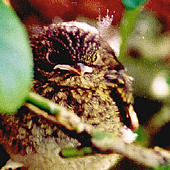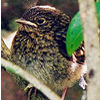Robins aren't as common in the garden as some of the other bird species, though in 2000 I was very pleased when a pair of robins chose to nest in the ivy here (see below). Despite their rearing several surviving young, numbers didn't seem to increase, and we didn't see many robins in recent years.
In the spring of 2006 I was pleased to see that a pair of young robins were visiting the bird table. I wouldn't have recognised them as young robins if I hadn't seen the ones raised in our garden previously, as the juveniles are speckled brown and don't have the familiar red breast.
The adults, of course, are very familiar. Though in different countries we have different birds we call "robin". The American robin has a red breast too but is a very different bird.
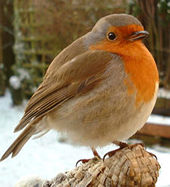
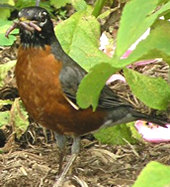 On the left - the European robin, the type we have in the garden here (Erithacus rubecula - to give it its proper name). On the right - the American robin (Turdus migratorius).
On the left - the European robin, the type we have in the garden here (Erithacus rubecula - to give it its proper name). On the right - the American robin (Turdus migratorius).
Thanks to Gale from Philadelphia for the photo of the American robin. The photo of the European robin is copyright CRS Photography.
Robins nesting: a record of their progress
In 2000, a pair of robins nested in the garden. As this was a first for my garden, I kept a record of the robins' progress, which is included below.
I didn't know what to expect, as only blackbirds had nested in the garden previously. Five young robins emerged from the nest, looking nothing like the parents, being small round speckled things (see photos on this page).
1st week in April - serious courtship
This morning three robins were involved in some strange and elaborate courting ritual around the bird table, offering and then withholding bits of food, one trying to lure another to the ivy (generally attractive nesting site it seems) while the third puffed out its body and hopped about in a peculiar and yet no doubt impressive way.
9 April - nest-building begins
The robins started nest building in the ivy, near the gate. Was worried that they
were too accessible to cats, but as always felt so privileged that they
had chosen a spot in my garden.
After turning the compost heap I left the lid off, and the robin kept going
there for its nesting materials. Such things are an added dimension to the
garden, and are crucial to my year-round enjoyment of it. Just at those
times when I get a bit down about problems out there, or perhaps that it
doesn't always live up to the perfect picture I have in my head, along comes
some creature passing through that maybe just temporarily makes a home in
my garden.
2 May - feeding each other, and the chicks
In the last week to ten days I had noticed the robins' feeding each
other, with one bringing gifts of food to the other, whereupon they'd
sing a trilling song of greeting. Then in the last five days or so they've
been taking food in to the chicks in the nest, in what seems like a relay. This activity is becoming
more frenetic, with the last trip back yesterday being in the dark, certainly
after what could be called 'dusk'.
Yesterday I heard the first audible cries from the chicks in the nest,
who were cheeping very quietly. Spike the cat noticed this too, so part
of my evening was spent stuffing twiggy branches in the gaps I thought
he might get through if he decided to bother them.
8 May - Busy from dawn until dusk, and hygenic too
The parents carry on as before, bobbing into the nest in the
ivy, provoking calls from the chicks that are getting louder every day.
I've also noticed the parent birds disposing of the faeces from the birds in the nest. A
neat bundle is in the beak, and the bird flies off out of our garden to
deposit it elsewhere.
Otherwise they're bringing something in, still in relay, in a busy kind
of fashion.
They feed their young until dusk or after. Have to say they seem
to be doing well at finding food - mainly caterpillars and flies it seems,
though also smaller earthworms. A lot of this they're getting from other
gardens nearby - they head off out of the nest at speed as if they're
going far afield, and seem to be covering quite an area.
Listening to the growing noise from the nest at feeding times - have heard at least one of them
developing a slightly different call - more of a differentiated 'cheep'.
I think they may be coming out soon.
12 May - leaving the nest
The robins came out of the nest today. I walked down the garden, hearing a chorus of distinctive cheeps. Small round speckled birds were found sitting in various places around the garden, cheeping in sequence. It was almost like there was one everywhere I looked. I counted five - it took a while to find them all, as they kept moving about.
16 May - keeping the cats in
The young robins are bombing about all over the garden. It's fascinating
to watch their progress.
I decided to keep the cats inside while the birds get a bit
better at flying. At the moment they're sitting targets, at least during
the day when they're all over the garden, mainly on the ground.
The cats don't seem to mind being kept in for a few days, and it's only
a temporary measure. Spike was a bit restless one evening, maybe wanting
to check his territory, so I carried him around the garden for a bit to
reassure him there were no impostor cats on his patch in his absence.
I took Leaps out too, in the interests of fairness.
Learning to fly
There are definite differences in the development of the young robins, some being obviously further developed than others when they left the nest. They couldn't fly to begin with, owing to lack of tail feathers. Last thing in the evening I watched one looking around for somewhere to fly to, shifting about looking like it was trying to pluck up the wherewithal to try it.
. . . and to roost
They seem to have a definite tendency, after the first day or two out of the nest, to move upwards from the ground as it gets to dusk. On the first night one did this, balancing on a stem of a clematis, which is still thin and doesn't provide much cover. The bird perched about three foot off the ground at the front, in full view of predators, its toes wrapped neatly around the stem, and its head tucked in so it looked like a small and rather fluffy golf ball.
18 May - confused parenting
I've noticed that another nest is being built by the parent, in the clematis, a few metres along from the original nest. The female (I assume it was her) seems confused by these two processes going on simultaneously, and often arrives with a beak full of nesting materials, which she then tries to feed to the young birds, obviously not very successfully.
19 May - moving off
Some proper flying has begun, though landing is still clumsy. The young birds have started to disperse, and I can hear at least one of them in the neighbouring gardens. I'm still watching them develop, and get used to the environment. One of them spent a while looking at the bird bath bowls on the ground, finally jumping into one and drinking. At dusk one of the young birds suddenly made the alarm call that the parents do - until then I'd only heard the 'cheep' which was the call for food.
23 May - fully flown
The robins seem to have all moved on - no sign of the parents or the young.
Though I could hear the parents' alarm calls from a few gardens away,
so I assume they're still feeding the young and have moved out with them.
There's no sign that the new nest is being used, and their absence seems
odd after their very definite presence for so many weeks.
Yesterday evening one of the adults appeared briefly, drinking out of
the water bowl they sometimes bathe in, then sat in the cherry tree, as
the other one appeared. They then flew off purposefully towards the other
gardens.
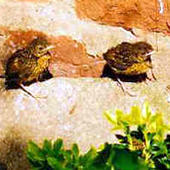
Young robins in the garden, spring 2000
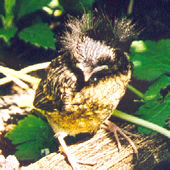
Above: one of the smallest of the brood.
